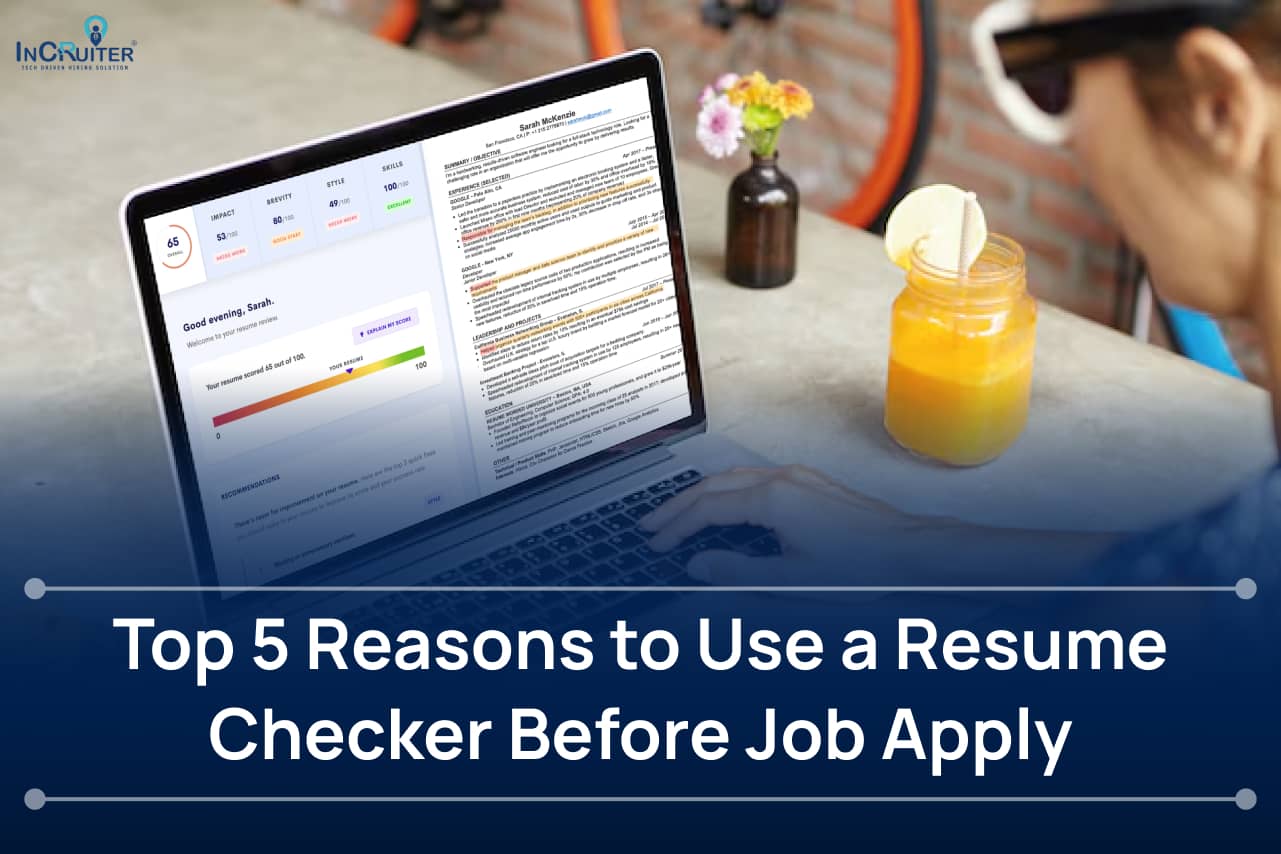In the rush to find the right candidate, recruiters often spend just seconds looking at resumes. This makes having a clean and well-structured resume essential. A study by Jobvite found that over half of recruiters reject resumes because of simple mistakes. On top of that, nearly 75% of companies use Applicant Tracking Systems (ATS) to sort through applications. These systems can filter out as many as 60% of resumes due to issues like bad formatting or missing important keywords. This means many resumes don’t even get a chance to be seen by a recruiter. Using a Resume checker can be a lifesaver in such situations.
It helps ensure your resume is easy to read and matches ATS requirements. Resumes with proper formatting and relevant keywords are much more likely to grab an employer’s attention. These small but powerful adjustments can boost your chances of getting interviews and moving closer to landing a job.
If you’re serious about improving your job applications, here are five simple reasons why a resume checker can make a real difference before you hit send.
Why you should use a Resume Checker before applying for jobs?
Landing a job often comes down to how well your resume aligns with the employer’s expectations. For example, recruiters at large corporations deal with thousands of resumes daily. Many resumes, despite showcasing strong qualifications, get rejected simply because they fail to meet technical or formatting standards. Here’s how resume checkers can give you an edge in such scenarios.
1. Ensures Your Resume is ATS-Friendly
Suppose you’re applying for a sought-after position at a Fortune 500 company. Their ATS scans resume for specific keywords like “budget forecasting” or “team leadership.” Without these keywords, your application could be automatically filtered out, even if you’re highly qualified.
Resume checkers analyze job descriptions and match your resume to these requirements. They ensure:
- The correct keywords are present, increasing your chances of passing the ATS scan.
- Proper formatting avoids issues like unreadable tables or excessive graphics that confuse the system.
By tailoring your resume for ATS compatibility, you position yourself for the next stage of consideration.
2. Identifies and Fixes Grammar and Spelling Errors
Zomato CEO Deepinder Goyal, in one television show, highlights that small mistakes in spelling or grammar can take away from even the most well-written resumes. Recruiters often see these slip-ups as signs of carelessness or unprofessional behavior. Despite your qualifications, such errors can leave a poor impression. In fact, a survey shows that more than half of recruiters, 52%, reject applicants immediately when they notice these mistakes.
Resume checkers can save you from these problems by carefully reviewing and improving key areas:
- Spelling Mistakes: Common errors like typing “manger” instead of “manager” or mixing up “effect” and “affect” get flagged. This helps ensure your resume sends the right message to employers.
- Grammar Checks: These tools make sure your sentences follow proper rules. For instance, they ensure past jobs are described in past tense (“Led a team of five”) while current roles use present tense (“Manage daily tasks”).
- Clearer Language: Resume checkers suggest ways to simplify complex phrases or awkward sentences. This keeps your writing clean, straightforward, and easy for recruiters to follow.
3. Provides Keyword and Content Optimization
Keywords are like secret codes that connect your resume to what a hiring manager or software is searching for. They’re the magic words that ensure your resume gets noticed, whether by a recruiter or an Applicant tracking system (ATS). If your resume doesn’t match up with the job description, it might just end up lost in the shuffle. That’s where a resume checker becomes your best friend.
Think about applying for a data analyst role. A resume checker might recommend adding terms like “data visualization,” “predictive modeling,” or “business intelligence tools” based on the job description. But it’s not about tossing in random buzzwords; it’s about working these terms into your accomplishments so they pack a punch.
For example, instead of writing something general like “Proficient in analytics,” you could refine it to:
- Developed predictive models using Python and SQL, reducing operational costs by 15%.
- Created interactive Tableau dashboards that improved executive decision-making by 20%.
This approach transforms your resume into a tailored, attention-grabbing document. It doesn’t just appeal to hiring managers; it also works seamlessly with ATS systems, increasing your chances of landing that interview.
By making these adjustments, your resume isn’t just another submission; it becomes a compelling story of what you bring to the table.
4. Enhances Formatting and Readability
A resume’s design and structure can significantly influence how recruiters perceive your application. Studies show that 76% of hiring managers say poorly formatted resumes are harder to read and more likely to be ignored. A resume checker ensures that your document is not only visually appealing but also easy to navigate, helping recruiters quickly find the information they need.
Here’s how resume checkers address common formatting issues:
- Font Consistency: They standardize fonts to professional styles like Arial or Calibri, ensuring readability across devices. Inconsistent font sizes and types, such as switching between Times New Roman and Comic Sans, can distract recruiters and convey a lack of professionalism.
- Section Alignment: Resume checkers align sections like “Work Experience,” “Skills,” and “Education” uniformly. Misaligned or cluttered sections can make a resume look chaotic, while clear alignment guides recruiters through your qualifications.
5. Saves Time and Makes Work Easier
Crafting a unique resume for each job application often feels like an endless chore. It’s tiring, and it steals away precious time that could be spent on tasks like connecting with others or preparing for interviews. Resume checkers step in as a helpful assistant, tackling the complicated bits so you can focus on the bigger picture.
Here’s how they simplify the process:
Swift Job Matching: These tools quickly review job descriptions and compare them with your resume. They highlight gaps, like missing skills, or suggest ways to better showcase your expertise. This helps align your resume with what the employer values most, making it more relevant and targeted.
Practical Tips: Whether you’re looking for a role in marketing, sales, or any other field, these tools offer tailored suggestions. Instead of starting over, you can tweak specific parts of your resume based on the advice, making it stronger without a lot of extra effort.
Quick Fixes for Formatting: Uneven fonts, alignment issues, or spacing problems can make any resume look unpolished. Resume checkers handle these details for you, tidying things up instantly and sparing you the hassle of doing it manually.
Also read: How Applicant Tracking Systems Shape Your Job Search?
Bonus Tips for Making the Most of Resume Checkers
Using a resume checker can boost your chances of landing interviews, but to truly make it work for you, a smart approach is key. Here are a few handy tips to help you get the best results from these tools:
1. Picking the Right Resume Checker: Free or Paid?
Not all resume checkers are the same. Free options can help with basic edits, but they often miss out on features like tracking applicant tracking system (ATS) compatibility or suggesting detailed keywords. Paid tools can offer:
- Complete Feedback: They check for grammar, layout, and ATS readiness all in one go.
- Keyword Insights: Advanced tools highlight key terms from job descriptions that you might have missed.
- Detailed Reports: Many paid tools create reports to help you improve with each version.
If you’re applying for many jobs or targeting competitive roles, then do not forget to try InCruiter resume checker.
2. Getting Your Resume Ready for Analysis
Before you upload your resume, spend a moment ensuring it’s ready for a proper review. This step helps the tool give you the most accurate advice:
- Use the Right File Type: Most tools work with PDFs or .docx files. PDFs keep your format intact, but .docx files make it easy to edit later.
- Update Your Information: Make sure your resume has the latest details about your skills, experience, and accomplishments. Missing info can lead to incomplete feedback.
- Organize with Clear Headings: Use straightforward headings like “Work Experience” or “Education” to make it easier for the tool to analyze your resume.
3. Using Feedback to Fine-Tune Your Resume
Running your resume through the checker once won’t be enough for a polished final version. Here’s how to improve it step by step:
- Focus on Key Fixes: Prioritize big changes, like adding keywords or fixing formatting issues.
- Tailor for Each Job: Adjust your resume for every role you apply to by adding relevant keywords and highlighting the right skills. Resume checkers can make this process faster and simpler.
- Re-check After Edits: Each time you make changes, upload your resume again to ensure all suggestions have been applied correctly. This way, your resume keeps getting better.
By following these steps, you can turn your resume checker into a powerful tool for creating a standout document that impresses employers.
Also read: How to get a job in Data Science and AI with NO prior experience?
Common Mistakes to Avoid When Using Resume Checkers
Resume checkers are useful tools that can improve your job applications, but how you use them matters a lot. Small mistakes can reduce their value and even harm your chances of standing out to recruiters. Here’s how to avoid some of the most common pitfalls:
1. Depending Too Much on Automated Suggestions
While resume checkers offer helpful advice, they aren’t flawless. Blindly following automated feedback can lead to issues like a stiff tone or awkward phrasing that might put off a recruiter.
For example, if the tool suggests adding more keywords, overdoing it can make your resume sound unnatural. After incorporating any suggestions, always review it yourself to ensure it sounds polished and professional.
2. Skipping Customization for Specific Jobs
Resume checkers are great for tailoring your resume, but sending out the same resume for every job wastes an opportunity to stand out.
Why it’s a problem: Each role focuses on different skills. A resume built for a marketing role won’t work as well for a business development position.
How to fix it: Use the tool to tweak your resume for every job. Add job-specific keywords, rewrite your summary to fit the role, and highlight accomplishments that match the position’s needs.
3. Using Generic File Names
A simple mistake like naming your file “Resume.pdf” can make it harder for recruiters to find your application. File names might seem small, but they leave an impression.
What works better: Rename your file to include your name, the job title, and perhaps the date. For instance:
- JohnDoe_Marketing_Jan2024.pdf
- JaneSmith_ProjectManager_Resume.docx
Why this matters: A clear file name shows professionalism and ensures your resume is easy to locate in a sea of applications.
4. Not Updating After Feedback
Many people think running their resume through the tool once is enough. That’s a mistake. Ignoring the need for updates can mean your resume still fails to impress.
For example, you might receive suggestions to include specific terms or adjust the layout, but if you skip these changes, your resume might not pass ATS filters or catch a recruiter’s eye.
What to do: Use the resume checker as part of an ongoing process. After making edits, run your resume through the tool again to ensure it’s fully optimized before sending it out.
Also read: How to Write an Effective Job Description: A Comprehensive Guide?
Wrapping Up
Your resume is more than just a piece of paper; it’s your first impression when applying for a job. With so many people competing for the same roles, it’s important to make your resume shine. This is where a resume checker can truly help. It provides five key benefits: ensuring compatibility with applicant tracking systems (ATS), catching and fixing mistakes in language or layout, enhancing keyword use, improving overall flow, and saving you precious time.
Even small changes can make a huge impact. Each tweak takes your resume one step closer to bypassing automated filters and capturing a recruiter’s interest. A well-crafted resume doesn’t just get noticed; it increases your chances of landing interview calls, bringing you closer to the job you’ve been aiming for.
Ready to take your job search up a notch? Try InCruiter Resume checker today!



















